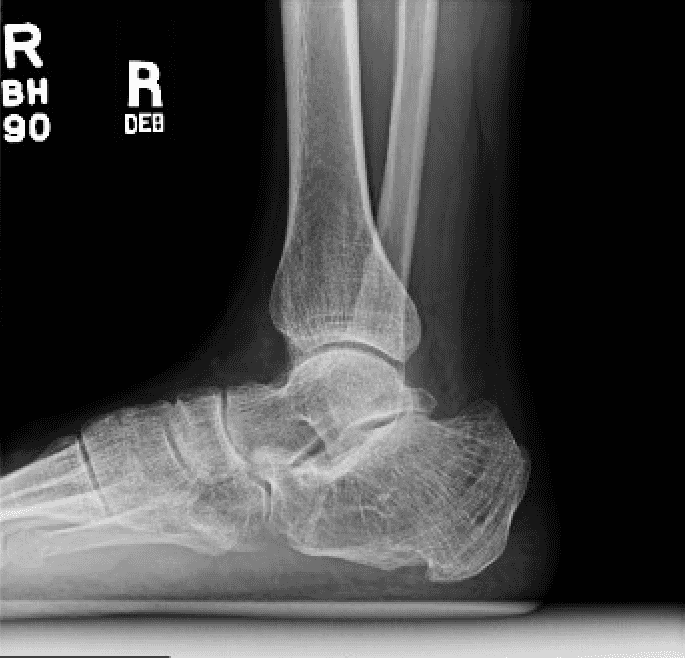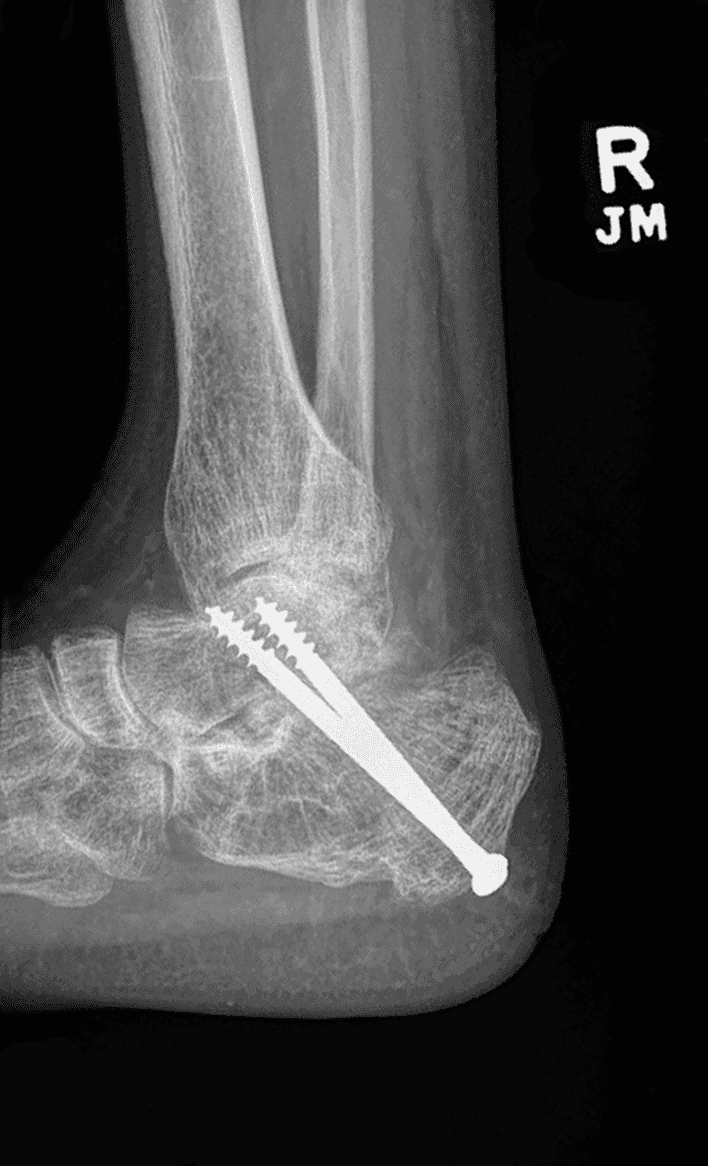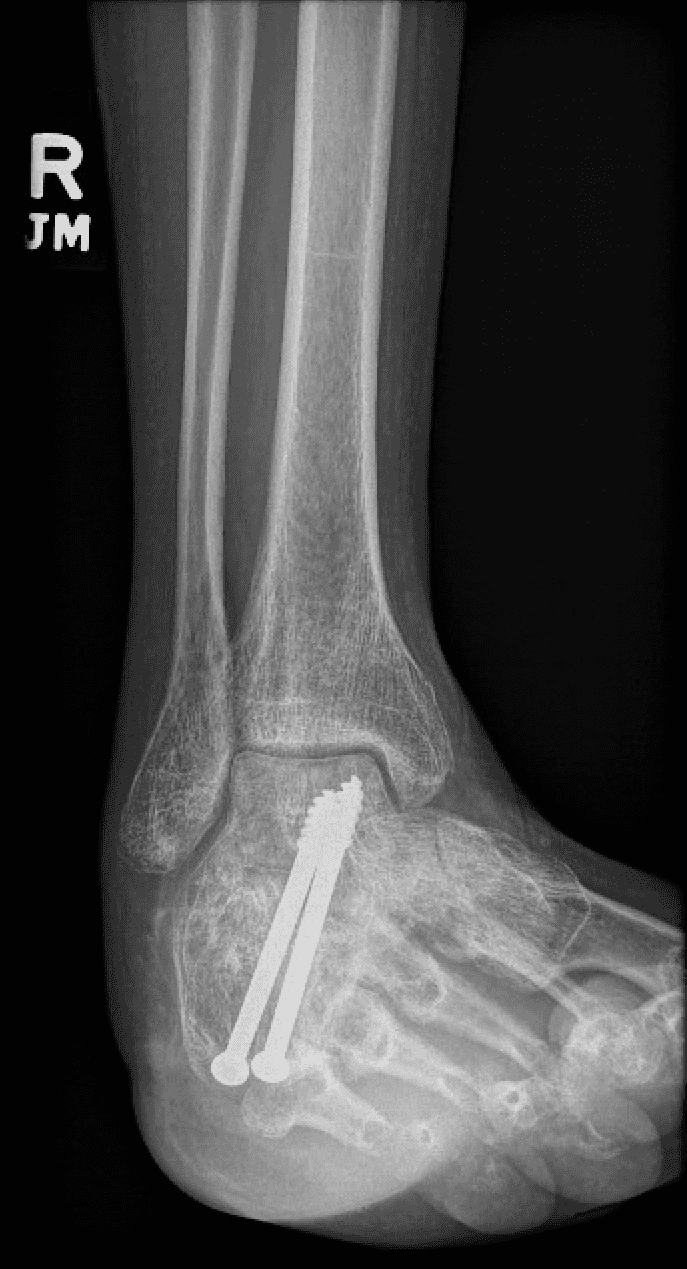Subtalar Arthrodesis for Post-Traumatic Subtalar Arthritis
Abstract
Subtalar arthrodesis is currently the mainstay treatment option for the management of recalcitrant subtalar arthrosis. Arthrosis is a degenerative joint condition that results in a painful, functionally-impaired joint. In the subtalar joint, this typically follows trauma to the hindfoot resulting in talus or calcaneus fractures in particular. Although anatomic reduction of these injuries reduces the chance of later complications, arthrosis is reported even following anatomical repairs. The goal of the fusion in this circumstance is to remove a painful joint. A broad range of both congenital and acquired foot conditions include subtalar arthrodesis as part of their management strategy.
This video article details the methods and techniques involved in subtalar arthrodesis. After an Ollier approach was used to expose the subtalar joint, the subchondral plates were prepared by inserting an autogenous bone graft. Finally, compression was achieved by two lag screws. The process of obtaining an autogenous bone graft from the proximal tibia using a bone harvesting device is also illustrated, and opinions and expectations on the future direction of the management of this arthritic joint condition are discussed.
Case Overview
Background
Subtalar arthrodesis is a well-tolerated treatment for remedying some of the most common symptoms that stem from advanced post-traumatic subtalar arthritis. The primary goals of this surgical procedure are to mitigate pain, restore alignment, and confer improved stability of the hindfoot by eliminating painful motion, arthritis, and deformity at the subtalar joint through fusion.
Painful arthritis and deformity are common sequelae after calcaneal fractures, the majority of which involve the subtalar joint. This bone supports all of one’s weight, helps maintain alignment and function of the structures around it, and comprises a significant portion of the subtalar joint above it which functions as the primary inverter and everter of the foot to facilitate accommodation on uneven surfaces. Disturbance of these relationships as a result of trauma to the bone and joint can therefore have profound consequences—making anatomic reduction and realignment critical during surgical fixation of calcaneal fractures for delaying the deterioration of the subtalar joint. Unfortunately, even in the best of circumstances many patients still go on to develop post-traumatic arthritis after calcaneal fracture, and unfortunately, there has yet to be a successful way to replace this joint once it has been damaged.
Conservative treatment options for post-traumatic subtalar arthritis include activity modification, orthoses, and corticosteroid injections. Minimally invasive procedures including arthroscopic debridement may provide relief, but are usually only temporizing. Arthrodesis—or fusion—has historically been the most reliable and definitive form of treatment once conservative measures are no longer adequate—and generally results in improved clinical outcomes if successful.
Subtalar fusion has the ability to not only eliminate the painful motion from the arthritic joint but also restore more normal anatomic alignment when necessary. When only fusion is indicated for the calcaneus and subtalar articulation then an in-situ arthrodesis can be performed with a 90% chance of success. When hindfoot realignment is also required, in order to improve altered mechanics or shoe-ability, additional, more complex procedures must be concomitantly performed to correct distorted anatomy, such as bone block grafting, osteotomy, tendon relocation or release, and other intervention. This video demonstrates the technique used for in-situ subtalar arthrodesis in a patient who developed subtalar arthritis 14 years after a calcaneus fracture ORIF.
The subtalar joint is a complex diarthrodial joint formed by the articulating surfaces of the anterior, middle, and posterior facets of the talus bone above and the calcaneus bone below. Since the majority of calcaneal fractures are intra-articular and result in articular surface disruption, attempts at surgical correction and fixation of these injuries as best possible are common. Intra-articular fracture of the calcaneus predisposes to subtalar joint degeneration (known as arthritis) via trauma-induced chondrocyte death and abnormal loading (contact pressures) that result from residual joint incongruency or malalignment.1 As such, anatomic reduction of the subtalar joint and restoration of hindfoot alignment as much as is feasible following injury are critical to maximizing patient outcome after calcaneal trauma. Although subtalar arthritis is known to be the final common pathway of most intra-articular calcaneal fractures, surgical reduction and fixation have been shown to maximize joint longevity and significantly slow the need for early fusion surgery. 2–5 Nonetheless, by virtue of the fact that many of these patients are often young at the time of injury and by definition damage a bone and joint complex that is forced to do more work and bear more load than most other parts of the body, many still end up facing the need for a second fusion procedure in their lifetime.
The primary function of the subtalar joint is to invert and evert the hindfoot and effectively transmit the load from ankle to foot. The subtalar joint, therefore, facilitates ambulation and shock absorption during gait and on uneven ground surfaces but also plays an important role in foot and ankle proprioception and propulsion during the gait cycle. As a result, advanced subtalar joint arthritis may be associated with significant limitation in performing both recreational and work-related activities. Subtalar joint arthrodesis alleviates pain and improves function by removing the injured articular surfaces, eliminating painful motion through the diseased joint, and restoring stable alignment. Patients usually benefit from deformity correction and restoration of stability to the hindfoot, with generally well-tolerated losses in subtalar motion.
Focused History of the Patient
The patient is a 45-year-old, otherwise, healthy male who developed post-traumatic arthritis of the subtalar joint 14 years following a work-related injury in which he sustained a comminuted, joint-depression type calcaneal fracture after a 10-foot fall from a ladder. He underwent acute open reduction and internal fixation (ORIF) of his calcaneus via a standard extensile lateral exposure following appropriate soft-tissue settling. He went on to routine fracture healing 12 weeks post-injury and eventually returned to work as a glazier 11 months after surgery. He later underwent implant removal and lateral calcaneal wall exostectomy for treatment of fibular impingement symptoms and hardware irritation approximately 8 months after his index procedure.
Seven years after the initial injury, the patient began to experience progressive hindfoot pain, primarily during weight-bearing or following activity. Imaging at this time revealed progressive degeneration of the subtalar joint, for which he was treated with orthoses, corticosteroid injections, and arthroscopic debridement. After exhausting both conservative and minimally invasive treatment measures at 14 years post-injury, he finally elected to undergo elective subtalar arthrodesis. At the time of this procedure, the patient’s medical and surgical histories were otherwise unremarkable. Plain radiographs of the hindfoot demonstrated complete healing of the calcaneal fracture and reasonable anatomic alignment, but end-stage degeneration of the subtalar joint.
Physical Exam
Patients presenting with fractures of the calcaneus often exhibit moderate to severe swelling and ecchymosis about the hindfoot. Overt or subtle deformity may also be evident. Classically, this involves shortening and widening of the heel in conjunction with varus hindfoot alignment. Peroneal tendon instability secondary to rupture of the peroneal retinaculum may also occur in up to 30% of fractures.6, 7 Due to the high-energy nature of these injuries, injury to other anatomic sites is not uncommon. Injury to the lumbar spine, in particular, has been classically associated with calcaneal trauma. Those who present with arthritis and/or deformity symptoms of a more chronic nature typically present with complaints of pain during gait or on uneven surfaces, difficulty wearing shoewear, ankle or hindfoot impingement, difficulty with push-off, and/or chronic swelling.
Imaging
Pre-op X-ray Image Post-op X-ray Images



Figure 1: Pre-op lateral ankle X-ray. Figure 2: Post-op lateral ankle X-ray. Figure 3: Post-op ankle X-ray.
Natural History
As with most arthritic processes involving the musculoskeletal system, the natural history of post-traumatic arthritis of the subtalar joint involves progressive joint degeneration and worsening symptoms of pain and stiffness. Clinically, patients experience progressive start-up and activity-related pain, increased joint immobility, and loss of function. While symptoms may be mitigated by conservative measures and activity modification, fusion surgery has stood the test of time as the most reliable and definitive form of treatment for this joint once symptoms have failed conservative measures—to date, no effective, durable joint replacement has ever been discovered akin to that for other major joints developing arthritis such as the hip, knee, and shoulder.
Options for Treatment
Subtalar arthrodesis is currently the most predictable means of permanently alleviating much of the pain from an arthritic subtalar joint. This is achieved by removing the diseased joint and creating an environment whereby the patient’s cells can hopefully fuse talus and calcaneus together.
There are a number of considerations that must be taken into account by both patient and surgeon when choosing a surgical approach. Each has respective advantages and disadvantages. Options for approaching the subtalar joint in order to fuse it include using one of the following: 1) all or part of a pre-existent extensile lateral incision, 2) making new arthroscopy portals from posteriorly or anterolaterally, and 3) the sinus tarsi (so-called Ollier) approach. The use of a prior incision may be advantageous in cases of planned hardware removal or if a bone distraction arthrodesis is to be performed which requires a large volume of exposure for graft introduction/fixation. It may also be helpful in cases whereby the surgeon also plans to address the peroneal tendons, is considering lateral wall decompression for impingement symptoms, or must simultaneously manage a sural neuropathy—since this exposure is typically located directly laterally over these anatomic regions. The alternative use of minimally invasive posterior arthroscopic incisions, on the other hand, can be advantageous when the joint remains easily manipulated and overall reasonably well aligned. This approach carries less surgical risk of wound complications, nerve injury, or infection/healing issues given its minimally invasive nature, but that advantage must be counterbalanced by the more limited exposure offered by these portals—so it must be selected in the right patients for whom all goals are still achievable through this exposure. Although a more technically demanding approach, arthroscopic exposure also has the advantage of being introduced through native (not previously scarred) tissue. Finally, a sinus tarsi approach or Ollier incision can be considered when none of the more involved adjunct procedures mentioned above (lateral wall decompression, distraction/fusion, etc.) are necessary to be accomplished in addition to the fusion procedure itself. This smaller, open approach provides the surgeon the ease of a fresh exposure with the advantages of lower surgical morbidity by virtue of this being a smaller exposure than using the former “L” shaped lateral incision that was previously used for fixing the broken calcaneus. Furthermore, a sinus tarsi approach affords better direct access to the subtalar joint than any single limb of an old extensile approach as it is placed directly over the joint, and it allows easier mobilization of a very stiff, scarred post-injury and post-surgical joint than an arthroscopic approach when this becomes necessary.
Discussion
In summary, the case presented is a 45-year-old male who underwent in-situ subtalar arthrodesis 14 years following surgical treatment for an intra-articular calcaneus fracture. Calcaneal trauma is one of several causes of subtalar arthritis that may ultimately benefit from subtalar arthrodesis. Subtalar arthritis may also occur secondary to talar fracture, subtalar dislocation, abnormal hindfoot alignment, or other disease states causing systemic arthropathy. Several studies have reviewed outcomes after calcaneus fracture management, and over 5 times the number of patients who sustain a calcaneal fracture will need to undergo subtalar fusion after initial conservative management as opposed to initial surgical realignment and fixation.3, 5, 7
The biomechanics of the hindfoot are complex. The normal anatomy of the subtalar joint allows for 30 degrees of inversion and 15 degrees of eversion. 8 The subtalar joint plays a critical role in transverse tarsal joint flexibility allowing for energy dissipation during heel strike. This is permitted by rapid eversion of the subtalar joint. In contrast, inversion of the subtalar joint locks the transverse tarsal joint to maximize power during toe-off. Prior biomechanical studies have found that talonavicular motion is reduced by 75% after subtalar arthrodesis by affecting this coupled locking and unlocking mechanism in the hindfoot.8
Surgical techniques for subtalar fusion are determined by surgical indication and anatomic considerations. In patients with preserved Bohler’s and talar declination angles, in-situ fusion is generally recommended. Prior studies have suggested improved outcomes in patients undergoing subtalar fusion after surgical treatment for a displaced intra-articular calcaneus fracture when compared to those managed non-operatively. Radnay et al retrospectively reviewed 69 patients with 75 fractures who underwent subtalar fusion for post-traumatic arthritis after calcaneal fracture. Improved Maryland Foot and American Orthopaedic Foot and Ankle Society (AOFAS) hindfoot scores were observed in those undergoing fusion after surgical fixation of their calcaneus fractures than those initially managed non-operatively. They concluded that initial open reduction and internal fixation lead to better outcomes by restoring calcaneal shape, alignment, and height, thus making in-situ fusion possible without necessitating extensive reconstructive adjuncts.2
Outcomes following in-situ subtalar fusion have, however, not been uniform, and these procedures are neither a guarantee of clinical improvement nor risk-free—and in no case do these patients end up with a “normal” foot post-treatment as if they had never sustained a calcaneal injury in the first place.10, 11, 12 Hollman and colleagues reported on 40 patients treated with subtalar arthrodesis for posttraumatic arthritis at a mean follow-up of 6.8 years. 9 The majority of patients reported less pain with a median Maryland Foot Score of 61. Quality of life remained significantly lower than reference populations, nonetheless, 90% of included patients indicated they would recommend the procedure to others suggesting high levels of satisfaction. 9 Hungerer and colleagues studied outcomes of primary and secondary (revision) subtalar arthrodesis in a large cohort of primarily worker’s compensation patients. Outcomes were relatively poor with a mean AOFAS hindfoot score of 47 and only 30% of patients returning to work following primary fusion.10 It should also be noted that reported fusion rates in primary subtalar arthrodesis vary considerably, with one study reporting a rate of pseudoarthrosis as high as 23.8%.11
Patients who have anterior or fibular impingement symptoms or significantly distorted anatomy may be indicated for subtalar arthrodesis with bone block distraction or osteotomy techniques. Rammelt and colleagues examined outcomes of distraction bone-block arthrodesis for calcaneal fracture malunions in 31 patients. Mean AOFAS hindfoot scores improved from 23.5 preoperatively to 73.2 at a mean follow-up of 33 months. Talocalcaneal height was corrected by nearly 62% and the talar declination angle by a mean of 38.5 degrees. They reported four complications including one dislocation of the bone block and one persistent infection.12
A number of techniques for in-situ subtalar fusion have also been described.13, 14 In the last fifteen years, the prone posterior arthroscopic technique has emerged as an attractive alternative to open fusion. In perhaps the most comprehensive report to date on the technique, Rungprai and colleagues retrospectively compared outcomes of this technique with a standard open fusion. They observed no difference in union rates, time to union or standard outcome measures. However, their results suggested that return to work time may be decreased with the arthroscopic technique.15
Various screw fixation constructs for achieving fusion have also been examined. DeCarbo and colleagues retrospectively reviewed 113 cases of subtalar fusion, divided between one and two screw fixation depending on surgeon preference. Fusion rates did not differ significantly between the two groups. Prior biomechanical studies, however, have favored two screw constructs.16 Chuckpaiwong and colleagues performed a cadaveric biomechanical analysis of four fusion constructs: a single talar neck screw, single talar dome screw, double parallel screws, and double diverging screws. Overall, higher compressive force, torsional stiffness, and resistance to rotation were observed with the double diverging screw constructs. 17
Finally, many options exist for bone grafting. While bone grafting is not critical for successful union, the use of bone graft has been associated with increased fusion rates. Common sites for autograft include the iliac crest, fibula, and proximal tibia, as used in our case. 13, 14 Autograft harvesting, however, is not benign and does confer additional surgical risks and the potential for donor site morbidity. The use of structural allografts has been more critical in reconstructive fusions. In recent years, alternatives to autogenous bone graft, including recombinant human platelet-derived growth factor-BB (rhPDGF-BB), have yielded promising results. In some instances, the use of alternative agents in both hindfoot and ankle fusion procedures has been shown to demonstrate higher fusion rates without the need for additional surgical incisions to harvest autologous bone, thereby avoiding the potentially chronic pain and/or alternative donor site morbidities frequently associated with autograft harvest.18
In the case presented, in-situ subtalar arthrodesis was recommended given the patient’s relatively preserved calcaneal height and anatomy as well as the desire to minimize further surgical risk. This was achieved with two parallel partially threaded large-fragment screws. Post-operatively, he was initially made non-weight bearing in a short leg cast and gradually transitioned to a walking boot at 6 weeks. By 4 months, he was fully weight-bearing in sneakers. He did undergo screw removal 7.5 months after surgery for symptomatic hardware. At the time of the last follow-up visit, 8 months after his fusion surgery, he reported a 50% improvement in his overall symptoms and function. He was fully weight-bearing and enabled to return to full work duties without restriction.
Disclosures
Nothing to disclose.
Statement of Consent
The patient referred to in this video article has given their informed consent to be filmed and is aware that information and images will be published online.
Citations
- Rammelt S, Bartoníček J, Park K-H. Traumatic Injury to the Subtalar Joint. Foot Ankle Clin. 2018;23(3):353-374. https://doi.org/10.1016/j.fcl.2018.04.004
- Radnay CS, Clare MP, Sanders RW. Subtalar Fusion After Displaced Intra-Articular Calcaneal Fractures. J Bone Jt Surg. 2010;92:32-43. https://doi.org/10.2106/JBJS.I.01267
- Csizy M, Buckley R, Tough S, et al. Displaced Intra-articular Calcaneal Fractures. J Orthop Trauma. 2003;17(2):106-112. https://doi.org/10.1097/00005131-200302000-00005
- Buckley R, Leighton R, Sanders D, et al. Open Reduction and Internal Fixation Compared With ORIF and Primary Subtalar Arthrodesis for Treatment of Sanders Type IV Calcaneal Fractures. J Orthop Trauma. 2014;28(10):577-583. https://doi.org/10.1097/BOT.0000000000000191
- Potter MQ, Nunley JA. Long-Term Functional Outcomes After Operative Treatment for Intra-Articular Fractures of the Calcaneus. J Bone Jt Surg. 2009;91(8):1854-1860. https://doi.org/10.2106/JBJS.H.01475
- Mahmoud K, Mekhaimar M, Alhammoud A. Prevalence of Peroneal Tendon Instability in Calcaneus Fractures: A Systematic Review and Meta-Analysis. J Foot Ankle Surg. 2018;57(Radiographics 25 2005):572-578. https://doi.org/10.1053/j.jfas.2017.11.032
- Richter M, Kwon J, DiGiovanni C. Foot Injuries; in Skeletal Trauma: Basic Science, Management and Reconstruction. 5<sup>th</sup> Edition. Chapter 67 p. 2251-2387. Elsevier Inc. 2015.
- Aston D, Detland J, Otis J, Kennealy S. Motion of the Hindfoot after Simulated Arthrodesis. J Bone Jt Surg. 1997;79(2):241-246. https://doi.org/10.2106/00004623-199702000-00012
- Hollman EJ, van der Vliet Q, Alexandridis G, Hietbrink F, Leenen L. Functional outcomes and quality of life in patients with subtalar arthrodesis for posttraumatic arthritis. Injury. 2017;48(7):1696-1700. https://doi.org/10.1016/j.injury.2017.05.018
- Hungerer S, Trapp O, Augat P, Bühren V. Posttraumatic arthrodesis of the subtalar joint – outcome in workers compensation and rates of non-union. Foot Ankle Surg. 2011;17(4):277-283. https://doi.org/10.1016/j.fas.2010.10.003
- Ziegler P, Friederichs J, Hungerer S. Fusion of the subtalar joint for post-traumatic arthrosis: a study of functional outcomes and non-unions. Int Orthop. 2017;41(7):1387-1393. https://doi.org/10.1007/s00264-017-3493-3
- Rammelt S, Grass R, Zawadski T, Biewener A, Zwipp H. Foot function after subtalar distraction bone-block arthrodesis. Bone Joint J. 2004;86-B(5):659-668. https://doi.org/10.1302/0301-620x.86b5.14205
- Coetzee CJ. Treatment of Hindfoot and Midfoot Arthritis, in Mann’s Surgery of the Foot and Ankle. Chapter 20, pg. 1008-1036. Elsevier Inc. 2014.
- Thordarson DB. Fusion in Posttraumatic Foot and Ankle Reconstruction. J Am Acad Orthop Sur. 2004;12(5):322-333. https://doi.org/10.5435/00124635-200409000-00007
- Rungprai C, Phisitkul P, Femino JE, Martin KD, Saltzman CL, Amendola A. Outcomes and Complications After Open Versus Posterior Arthroscopic Subtalar Arthrodesis in 121 Patients. J Bone Jt Surg. 2016;98(8):636-646. https://doi.org/10.2106/jbjs.15.00702
- DeCarbo WT, Berlet GC, Hyer CF, Smith BW. Single-Screw Fixation for Subtalar Joint Fusion Does Not Increase Nonunion Rate. Foot Ankle Specialist. 2010;3(4):164-166. https://doi.org/10.1177/1938640010368992
- Chuckpaiwong B, Easley ME, Glisson RR. Screw Placement in Subtalar Arthrodesis: A Biomechanical Study. Foot Ankle Int. 2009;30(02):133-141. https://doi.org/10.3113/FAI-2009-0133
- DiGiovanni CW, Lin SS, Baumhauer JF, et al. Recombinant Human Platelet-Derived Growth Factor-BB and Beta-Tricalcium Phosphate (rhPDGF-BB/&bgr;-TCP). J Bone Jt Surg. 2013;95(13):1184-1192. https://doi.org/10.2106/jbjs.k.01422

